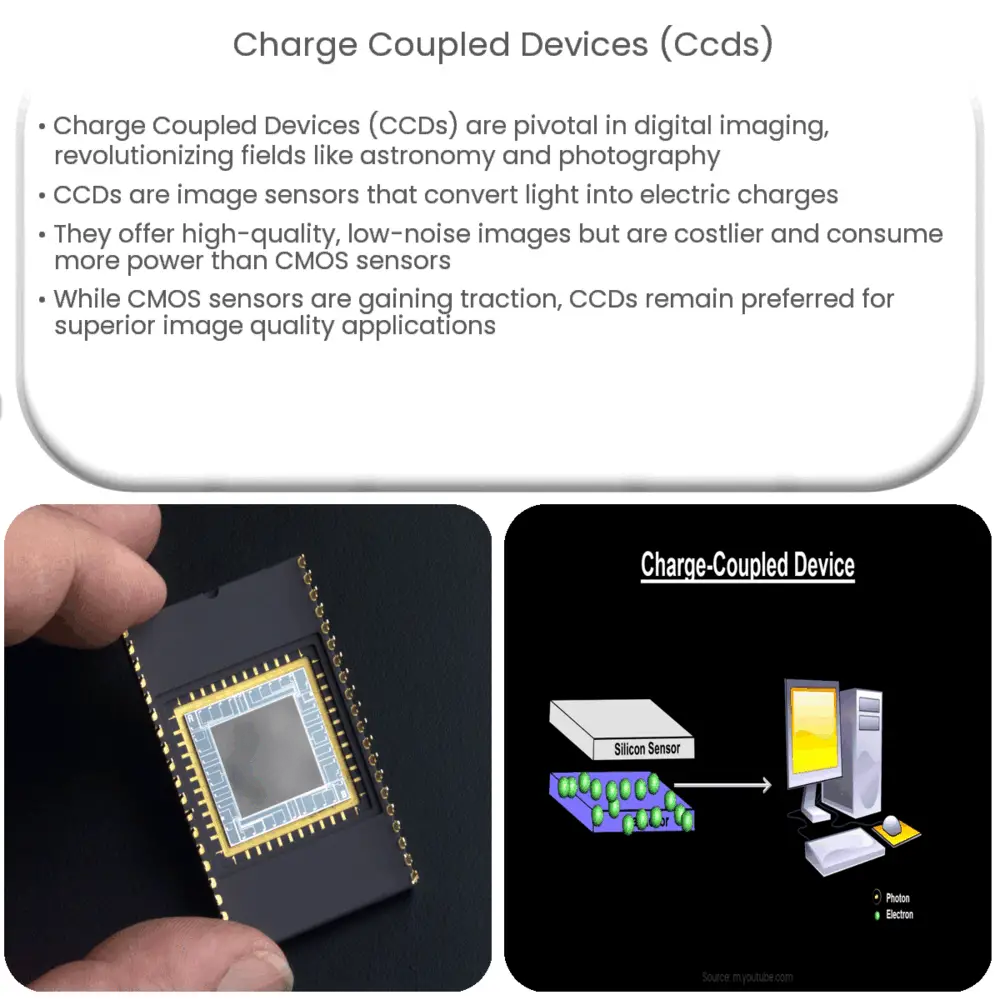Explore the world of Charge Coupled Devices (CCDs), their functioning, types, applications, pros & cons, and future in digital imaging.

Introduction to Charge Coupled Devices (CCDs)
Charge Coupled Devices (CCDs) represent a significant technology in the field of digital imaging. Invented in the late 1960s at AT&T Bell Labs, they have transformed numerous fields including astronomy, digital photography, and medical imaging.
What are Charge Coupled Devices (CCDs)?
At their core, CCDs are a type of image sensor, consisting of an integrated circuit etched onto a silicon surface, forming light-sensitive elements called pixels. Each pixel captures light photons and converts them into an electric charge proportional to the intensity of the light.
Operating Principle
- Photon Capture: When light strikes the CCD, it interacts with the silicon structure of the CCD. Each photon striking a silicon atom can create an electron-hole pair.
- Charge Storage: The electric charges produced are stored in a potential well at each pixel site. The amount of charge is proportional to the brightness of the light.
- Charge Transfer: After exposure to the light source, the charges in each cell are sequentially transferred and read at one corner of the array.
Types of CCDs
- Full Frame CCD: These devices utilize the entire pixel area for photon capture. After exposure, the charges are transferred to a temporary storage area covered by an opaque layer.
- Frame Transfer CCD: Similar to full-frame devices, except they have no need for a mechanical shutter due to the presence of an additional storage area that is not light-sensitive.
- Interline Transfer CCD: In these devices, each pixel has an associated charge transfer channel. This allows for a more rapid read-out of the image, which makes it ideal for video applications.
Applications of CCDs
CCDs play a crucial role in a variety of industries. In astronomy, for instance, they are used in telescopes to capture light from distant celestial bodies. In medical imaging, CCDs are used in devices such as endoscopes and digital x-ray machines. They are also ubiquitous in digital photography and video recording equipment, providing high-resolution images with excellent color fidelity.
Advantages and Disadvantages of CCDs
Charge Coupled Devices are appreciated for their superior image quality. They provide low noise, high resolution images that are especially useful in low light conditions. Their structure allows them to provide a high dynamic range, making them perfect for scientific and professional applications.
- Advantages: CCDs provide high-quality, low-noise images. They are highly sensitive to light, have a high dynamic range and produce accurate colors. They are also very reliable, making them the ideal choice for serious photography and scientific applications.
- Disadvantages: CCDs are more complex and expensive to manufacture than their main competitor, CMOS sensors. They also consume more power and are therefore less suited for battery-powered devices. In addition, CCDs are slower than CMOS sensors in processing images, limiting their use in high-speed applications.
The Future of CCDs
While CMOS sensors have gained in popularity due to their lower cost and power consumption, CCDs continue to be the preferred choice for applications that require superior image quality. Current research is focused on enhancing the efficiency of CCDs, making them more competitive in the growing digital imaging market.
Conclusion
In conclusion, Charge Coupled Devices (CCDs) have profoundly impacted the field of digital imaging. Their ability to transform light into electronic signals has made them indispensable in many areas, from astronomy to medical imaging to digital photography. Despite challenges from other technologies like CMOS sensors, CCDs retain a significant role in the sector due to their superior image quality. As technology advances, we can expect further improvements to these devices and possibly new areas of application.

